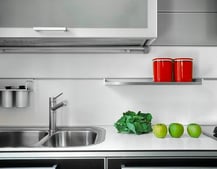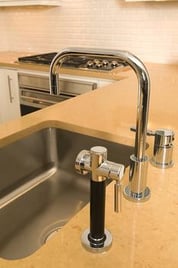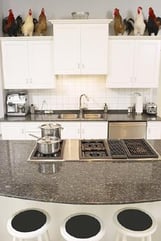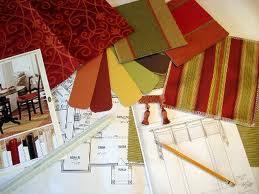LED Lighting Guide for Contractors

A clear understanding of how LED lighting works can open immense possibilities for contractors to be able to evaluate and compare performance of luminaires. It will also enable providers to propose the right luminaires for clients based on knowledge of light installations and how they are predicted to perform.
Benefits of LED Lighting
 LED or light-emitting diode has revolutionized light installations. This type of lighting requires less energy and loses less heat. The life of a LED bub is longer compared to the traditional ones. Life spans are quoted by companies from 50,000 to 100,00 hours or nearly 100 times longer than the traditional bulb.
LED or light-emitting diode has revolutionized light installations. This type of lighting requires less energy and loses less heat. The life of a LED bub is longer compared to the traditional ones. Life spans are quoted by companies from 50,000 to 100,00 hours or nearly 100 times longer than the traditional bulb.
In addition, it does not need a lot of maintenance and replacement making it cost-effective. To demonstrate, a typical LED lighting will produce over 100 lumens per watt (LPW). Lumen is the amount of light emitted from a source. A 100W incandescent bulb will produce the same luminosity but will use up more energy compared to LED bulbs.
Not only is LED cost-effective, it has outstanding color quality and excellent efficiency. Color rendering index (CRI) is the term used to define the ability of light or lamp to replicate the colors of an object on a scale of 1 to 100 where 100 is the equivalent of sunlight.
LED lighting is also smaller and compact, an easy and quick job for contractors.
What to Look for When Purchasing LED Lighting
The most important specification when buying LED is lumen output. This means that when proposing lights for certain living spaces, you will consider the amount of light it produces (brightness) and ensure it is adequate for your customers' requirements. For example, you will need brighter lights in working spaces such as the kitchen and dimmer lights in the bedroom to induce sleep.
 Then you will need to look at the LPW or lumens per watt. Put simply, this is the amount of lumens produced for every watt that is used. The higher the number, the better it is in order to match the CCT or the correlated temperature (measurement of coolness or warmth) measured in kelvins (K). It indicates whether a light is warm, neutral or cool white in appearance. Finally, you have to compare the CRI, with a higher rating a better choice, that is, greater than 80 is rated as good and greater than 90, very good.
Then you will need to look at the LPW or lumens per watt. Put simply, this is the amount of lumens produced for every watt that is used. The higher the number, the better it is in order to match the CCT or the correlated temperature (measurement of coolness or warmth) measured in kelvins (K). It indicates whether a light is warm, neutral or cool white in appearance. Finally, you have to compare the CRI, with a higher rating a better choice, that is, greater than 80 is rated as good and greater than 90, very good.
Other Features to Consider
Safety certifications vary across different regions in the world such as UL, ETL, CSA, NOM and CE. Products must be rated for moisture conditions and intended use/application such as dry, damp or wet. You might see two codes: ingress protection (IP) and insulation contact (IC). IP ratings consist of two numbers: first one indicates protections against solids including dust (0-6 where 0 means not protected and 6 well-protected). IC ratings indicate protections against liquids (0-8 where 0 means not protected and 8 means that it can be submerged in liquids).
Overall, contractors have a large number of reasons for using LED light bulbs as opposed to rival bulb types. As mentioned above these range from flexibility of design and function, to lower energy costs and longevity. The LED bulb's market share is growing just as its purchase price decreases. This is giving contractors the perfect opportunity to create new, stunning and innovative designs, features, and displays that has not been possible until now. Using LEDs will give you the design edge you are looking for to stand out from the crowd.
Guest Blogger: Leigh Marcos worked in home design and lighting before becoming a mother of two and a freelance writer. A keen photographer, she enjoys taking her dogs for long walks through the countryside in the hope of getting that perfect shot.



 Installed below the countertop, undermount-style sinks offer consumers an easy cleanup in the kitchen and a seamless look. However, contractors should know that this style of sink can only be used with solid-surface kitchen countertops, such as granite, composite or marble. Undermount sinks are an affordable option, and like drop-in sinks, these are available in a variety of different materials — like enameled cast-iron — for example, and colors to fit a kitchen’s design.
Installed below the countertop, undermount-style sinks offer consumers an easy cleanup in the kitchen and a seamless look. However, contractors should know that this style of sink can only be used with solid-surface kitchen countertops, such as granite, composite or marble. Undermount sinks are an affordable option, and like drop-in sinks, these are available in a variety of different materials — like enameled cast-iron — for example, and colors to fit a kitchen’s design. Bamboo
Bamboo When it comes to your remodeling business, you want to be the best and stand leagues above your competition. But in a crowded field, this can be tough to do. Your customers expect professionalism and a job well done, which is what most of your peers are aiming to deliver as well. So if you’re seeking that extra edge with your business, you need to also do this – and then some. One of the best ways to impress your customers is by staying abreast of industry trends, and the newest innovations that can save them money and improve their results. Here are a couple of the ones worth watching, in commercial and residential remodeling, along with some tips for keeping yourself in the loop.
When it comes to your remodeling business, you want to be the best and stand leagues above your competition. But in a crowded field, this can be tough to do. Your customers expect professionalism and a job well done, which is what most of your peers are aiming to deliver as well. So if you’re seeking that extra edge with your business, you need to also do this – and then some. One of the best ways to impress your customers is by staying abreast of industry trends, and the newest innovations that can save them money and improve their results. Here are a couple of the ones worth watching, in commercial and residential remodeling, along with some tips for keeping yourself in the loop. Just as marketing techniques have all been swept up in the concept of personalization recently, remodeling is not exempt from this trend. In fact, it’s arguable that being adaptable to your customers’ wish lists is the only way you’ll succeed. You might be thinking – wait, isn’t the practice of remodeling personalized already? Yes and no. Yes, because when you remodel a home, you renovate the areas your customer has specified. But it’s not extensively personalized, since many remodeling companies don’t take it a step further and find out how to tailor every bit of construction to the customers’ wants.
Just as marketing techniques have all been swept up in the concept of personalization recently, remodeling is not exempt from this trend. In fact, it’s arguable that being adaptable to your customers’ wish lists is the only way you’ll succeed. You might be thinking – wait, isn’t the practice of remodeling personalized already? Yes and no. Yes, because when you remodel a home, you renovate the areas your customer has specified. But it’s not extensively personalized, since many remodeling companies don’t take it a step further and find out how to tailor every bit of construction to the customers’ wants. Guest Blogger: Rebecca Hasulak is a prolific writer and dangerous dreamer. She sharpened her skill with the written word while she was an Associate Editor of a beauty and pop culture magazine, and further during her time as a Public Relations Executive. Rebecca now writes and delivers PR services under her business Quotable PR, and is happiest when with her daughter and loved ones. Follow her @BecksChristine.
Guest Blogger: Rebecca Hasulak is a prolific writer and dangerous dreamer. She sharpened her skill with the written word while she was an Associate Editor of a beauty and pop culture magazine, and further during her time as a Public Relations Executive. Rebecca now writes and delivers PR services under her business Quotable PR, and is happiest when with her daughter and loved ones. Follow her @BecksChristine.
 Bathroom renovations make homes more modern, but the return on this investment is lower compared to other home remodeling projects. The average amount recouped from a mid-range bathroom project (those costing around $16,000) upon selling is 70 percent of total costs,
Bathroom renovations make homes more modern, but the return on this investment is lower compared to other home remodeling projects. The average amount recouped from a mid-range bathroom project (those costing around $16,000) upon selling is 70 percent of total costs,  Most homeowners already have a budget in mind for their bathroom renovation. This is where a contractor's expertise can win the trust of prospective clients.
Most homeowners already have a budget in mind for their bathroom renovation. This is where a contractor's expertise can win the trust of prospective clients. A common theme for master bathrooms these days is removing the tub altogether in favor of a spa. Of course, there are caveats when it comes to installing an indoor hot tub—for starters, they are large and difficult to get indoors, and many must be installed on a ground floor due to their weight. In addition, there could be problems with humidity levels when the spa cover is removed and floor damage if the unit leaks,
A common theme for master bathrooms these days is removing the tub altogether in favor of a spa. Of course, there are caveats when it comes to installing an indoor hot tub—for starters, they are large and difficult to get indoors, and many must be installed on a ground floor due to their weight. In addition, there could be problems with humidity levels when the spa cover is removed and floor damage if the unit leaks,  Guest Blogger: Brian Wilkins is an Arizona State University journalism grad who has worked as a radio broadcaster and banking industry professional. He is an independent journalist, blogger and small business owner who loves life. He lives off-the-grid and has not owned a TV in more than six years.
Guest Blogger: Brian Wilkins is an Arizona State University journalism grad who has worked as a radio broadcaster and banking industry professional. He is an independent journalist, blogger and small business owner who loves life. He lives off-the-grid and has not owned a TV in more than six years. If your goal is to grow your remodeling business past the $1Million installed sales volume threshold the business will need a design and or specification process. That process must support the ability to perform a "handoff" between the salesperson and the production team that will build sold projects. Without adequate plans and specifications the production team and a project's lead carpenter will be constantly contacting the salesperson for the information needed to build what the customer is expecting.
If your goal is to grow your remodeling business past the $1Million installed sales volume threshold the business will need a design and or specification process. That process must support the ability to perform a "handoff" between the salesperson and the production team that will build sold projects. Without adequate plans and specifications the production team and a project's lead carpenter will be constantly contacting the salesperson for the information needed to build what the customer is expecting. Be honest not only to your customers, but also with yourself. I fortunately recognized very early in the building of my business that I was not a designer. I can build any design you give me, I just don't have the right talents to design renovations at the level my target customer expected and deserved. So, if you do offer or plan to offer design services make sure you find the right talent to do so. That person
Be honest not only to your customers, but also with yourself. I fortunately recognized very early in the building of my business that I was not a designer. I can build any design you give me, I just don't have the right talents to design renovations at the level my target customer expected and deserved. So, if you do offer or plan to offer design services make sure you find the right talent to do so. That person  First, make sure you can legally offer design service where your business operates. Next, make sure you and or your employees have the right construction, product and building science knowledge and experience to offer design and or specification assistance. Value engineering for a prospect may help you sell a project, but what if you suggest or substitute products that compromise the design, the structure and or the purpose of the project? You may own the end result and it could cost you a lot of money.
First, make sure you can legally offer design service where your business operates. Next, make sure you and or your employees have the right construction, product and building science knowledge and experience to offer design and or specification assistance. Value engineering for a prospect may help you sell a project, but what if you suggest or substitute products that compromise the design, the structure and or the purpose of the project? You may own the end result and it could cost you a lot of money.  This may seem like an obvious point but here me out. If your goal is to bust past $1Million your plans and specifications should include not just what might be needed to sell the job and or get a permit. Your plans and specs should really be communication tools that your production team will use to build from. Measurements, product sizes, rough opening dimensions, center lines and clearances all become critical when building, and even more critical if you want to protect your margins and project schedules. With the right plans and specifications you can protect your profits and only have to build the project once.
This may seem like an obvious point but here me out. If your goal is to bust past $1Million your plans and specifications should include not just what might be needed to sell the job and or get a permit. Your plans and specs should really be communication tools that your production team will use to build from. Measurements, product sizes, rough opening dimensions, center lines and clearances all become critical when building, and even more critical if you want to protect your margins and project schedules. With the right plans and specifications you can protect your profits and only have to build the project once. As produced volume increase for a remodeler, that remodeler must decide between being a contractor and a construction business owner. As a contractor you can do all of the above yourself, but breaking $1Million will be challenging, require lots of work hours and may not be practical depending on your target project types. As a construction business owner your role will be to profitably run the business not the jobsite. If that is your goal make sure your team members will be creating the information each department needs to successfully sell profitable projects and perform their assigned responsibilities.
As produced volume increase for a remodeler, that remodeler must decide between being a contractor and a construction business owner. As a contractor you can do all of the above yourself, but breaking $1Million will be challenging, require lots of work hours and may not be practical depending on your target project types. As a construction business owner your role will be to profitably run the business not the jobsite. If that is your goal make sure your team members will be creating the information each department needs to successfully sell profitable projects and perform their assigned responsibilities.






 To help your work stand out from other contractors don’t settle for the same old same old when it comes to designing driveways for your clients. You can mix and match materials like asphalt and brick border, or broken concrete and gravel. Instead of a straight path from the street to the garage, consider a rolling driveway layout to add some sensuous curved lines to the property.
To help your work stand out from other contractors don’t settle for the same old same old when it comes to designing driveways for your clients. You can mix and match materials like asphalt and brick border, or broken concrete and gravel. Instead of a straight path from the street to the garage, consider a rolling driveway layout to add some sensuous curved lines to the property.
 Guest Blogger: Heidi Cardenas is a freelance writer with a background in human resources, business administration, technical writing and corporate communications. She specializes in human resources, business and personal finance, small business advice and home improvement.
Guest Blogger: Heidi Cardenas is a freelance writer with a background in human resources, business administration, technical writing and corporate communications. She specializes in human resources, business and personal finance, small business advice and home improvement.
 The architect either invites multiple contractors to bid on the project or gives the homeowner the names of 5 (or more) contractors to bid on the project, essentially setting up an auction. So 5 contractors and all their subs do free estimates for the chance to be the lowest bidder (biggest loser). Then when the home owner actually buys from a contractor they are the ones paying for all the free estimates that contractor did for the people who did not buy. I think it would be interesting to hear the reaction home owners might have if they knew they were paying for other home owners’ free estimates.
The architect either invites multiple contractors to bid on the project or gives the homeowner the names of 5 (or more) contractors to bid on the project, essentially setting up an auction. So 5 contractors and all their subs do free estimates for the chance to be the lowest bidder (biggest loser). Then when the home owner actually buys from a contractor they are the ones paying for all the free estimates that contractor did for the people who did not buy. I think it would be interesting to hear the reaction home owners might have if they knew they were paying for other home owners’ free estimates. Many architects take the plans too far before knowing if the customer can actually afford the project and or if the project can actually be built. I think this is one of the worst things architects do to their customers. Wouldn’t it make sense to make sure the there are no zoning issues and that the project and or the scope are realistic before spending the client’s money to bring the plans from concept to ready to apply for permit?
Many architects take the plans too far before knowing if the customer can actually afford the project and or if the project can actually be built. I think this is one of the worst things architects do to their customers. Wouldn’t it make sense to make sure the there are no zoning issues and that the project and or the scope are realistic before spending the client’s money to bring the plans from concept to ready to apply for permit? They over-design the project past the agreed budget without providing realistic insight about the additional costs. Again, assuming the architect agreed to design to a budget, refer to number 2 above. If the home owner asks for things and or the architect suggests things that will blow the agreed budget, shouldn’t the architect make the true price difference clear to the home owner first and ask if they will commit to increasing their budget before expanding the design and collecting bids from contractors?
They over-design the project past the agreed budget without providing realistic insight about the additional costs. Again, assuming the architect agreed to design to a budget, refer to number 2 above. If the home owner asks for things and or the architect suggests things that will blow the agreed budget, shouldn’t the architect make the true price difference clear to the home owner first and ask if they will commit to increasing their budget before expanding the design and collecting bids from contractors?

 Over the years, I have heard from many contractors — some of them with very big companies — about how they handle drafting their business contracts. Many times, these documents consist of a collection of "stuff some guys I know have in their contracts" cobbled together. It doesn't even occur to these business owners that laws vary by state, or that they might need an expert to customize contracts to fit their own business's unique needs. By not having a professional create legal documents that fit a clear sales procedure and overall company goals, they are putting their company at serious risk. I know because we learned the hard way, too.
Over the years, I have heard from many contractors — some of them with very big companies — about how they handle drafting their business contracts. Many times, these documents consist of a collection of "stuff some guys I know have in their contracts" cobbled together. It doesn't even occur to these business owners that laws vary by state, or that they might need an expert to customize contracts to fit their own business's unique needs. By not having a professional create legal documents that fit a clear sales procedure and overall company goals, they are putting their company at serious risk. I know because we learned the hard way, too.  In 1998, we incorporated as Myers Constructs, Inc., because we had taken on a huge and complicated renovations project. We knew we needed serious business structures in place to protect us, so in 2001 we asked Dana Priesing, an attorney who is now our office manager, to read our contracts to look for problems. (She had us sign a contract before she did so!) Dana interviewed Tamara to better understand how she sells, and how our customers buy, and then gave us a few recommendations right off the bat:
In 1998, we incorporated as Myers Constructs, Inc., because we had taken on a huge and complicated renovations project. We knew we needed serious business structures in place to protect us, so in 2001 we asked Dana Priesing, an attorney who is now our office manager, to read our contracts to look for problems. (She had us sign a contract before she did so!) Dana interviewed Tamara to better understand how she sells, and how our customers buy, and then gave us a few recommendations right off the bat:


 My suggestion to design/build firms is to have a decorator either on staff or one you’ve built a good relationship with available to you, that is willing to work in conjunction with the designer and/or contractor as far as the pretty aspect of such things as tile lay-out, mirror and sconce placement goes. This is where creating a team comes into play. When all parties are able to communicate clearly with one another and work together everyone wins. That’s the whole point - everyone does what they’re good at, has a good time and works together so more business is forth-coming.
My suggestion to design/build firms is to have a decorator either on staff or one you’ve built a good relationship with available to you, that is willing to work in conjunction with the designer and/or contractor as far as the pretty aspect of such things as tile lay-out, mirror and sconce placement goes. This is where creating a team comes into play. When all parties are able to communicate clearly with one another and work together everyone wins. That’s the whole point - everyone does what they’re good at, has a good time and works together so more business is forth-coming.





